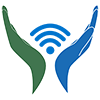In the heart of a bustling western city, amidst the towering skyscrapers and bustling streets, a young woman named Aisha lived. She arrived in the town with nothing but a suitcase full of dreams and a heart filled with hope.
Aisha’s journey commenced in a small village in the heart of the Middle East, a place where simplicity coexisted with hardship. As the eldest daughter in a family grappling with the arduous task of rebuilding their homeland in the aftermath of war, Aisha felt the weight of responsibility upon her shoulders. Determined to alleviate her family’s struggles, she made the bold decision to venture abroad, seeking employment opportunities that would enable her to send financial support back home.
From the moment she arrived, Aisha quickly discovered a world where digital tasks covered every aspect of daily life, and everything was accomplished with the tap of a screen: Need to pay your bills? There’s an app for that. Want to book a doctor’s appointment? Just log on to the website. Craving a midnight snack? Head to the self-service machines at the supermarket. For Aisha, who had grown up in a place where technology was a luxury reserved for the privileged few, the sheer convenience of it all was nothing short of miraculous. Gone were the days of waiting in long lines or fumbling with paperwork—here, everything was fast, efficient, and effortlessly streamlined.
However, beneath the surface of the digital paradise, Aisha discovered a troubling reality. In a society where everything was online, those without access to the internet were left behind. As a newcomer struggling to navigate the complexities of a new language and culture, Aisha found herself on the wrong side of the digital divide. The internet, once a symbol of opportunity, now felt like an insurmountable barrier between her and the promise of a better life, separating them from the opportunities the city promised.
Aisha’s journey mirrored this struggle against the digital divide. As she settled into re-starting her life,, she encountered the challenges of navigating online systems that overlooked the needs of diverse communities. Like Aisha, many newcomers faced barriers in accessing digital resources, highlighting the urgent need for inclusive practices in education and beyond. Our unconscious bias led us to believe that an online application link equated to universal accessibility. However, the reality was far from it. Data underscores the digital divide, revealing stark discrepancies in internet access and digital literacy. According to recent studies, approximately 3.7 billion people worldwide still lack access to the internet, with significant disparities persisting across regions and demographics.
In my role within the field of education, I’ve come to realize the inherent challenges of assuming inclusivity in our programs, particularly when it comes to digital accessibility. When we create online application forms, there’s often an underlying assumption that they cater to everyone, irrespective of their background or circumstances. We believe that simply providing a digital link is enough for universal access, assuming that individuals from all walks of life can effortlessly navigate our online systems.
We assumed that by providing a digital platform, we were inherently inclusive, catering to all demographics. Yet, our assumptions were flawed, overlooking the unique challenges faced by newcomers from societies where digital literacy may not be as prevalent. Moreover, within immigrant communities, language barriers and unfamiliarity with digital interfaces compound these challenges.
It’s in recognizing the fallacy of these assumptions that we understand the true essence of inclusivity. Merely digitizing our programs is not sufficient; we must actively strive to bridge the digital divide. This requires offering alternative application methods that accommodate diverse needs, such as in-person submission, digital skills trainings, online literacy or providing multilingual support.
In essence, true inclusivity demands a concerted effort to ensure accessibility for all, regardless of their background or circumstances. By acknowledging and addressing the limitations of our digital platforms, we can take meaningful steps towards creating a more equitable and accessible educational landscape.
Thus, Aisha and I embarked on parallel journeys—she, determined to bridge the digital gap for herself and her community, and I, committed to understanding and addressing the digital divide through educational programs. As Aisha navigated the challenges of accessing digital resources in her new environment, I delved deeper into understanding the nuances of the digital gap and creating initiatives to empower women with digital skills.
Drawing from Aisha’s firsthand experiences and those of other newcomer women, we endeavored to create educational opportunities aimed at empowering women with the digital tools essential for navigating the system and seizing online opportunities for personal and professional growth. Together, we sought to inspire others to raise awareness about the digital gap and to build bridges toward a more inclusive society. Recognizing the importance of collective action, we endeavored to dismantle the barriers hindering inclusivity.
In conclusion, Aisha’s journey, along with the experiences of countless other newcomer women, underscores the critical need for initiatives which aim to equip individuals with the digital literacy necessary to thrive in today’s interconnected world. By championing grassroots NGOs, we address immediate needs and contribute to the UN Sustainable Develpment Goals (SDGs) broader global agenda. Through collaborative efforts, we can bridge the digital gap and pave the way for a more inclusive society with equal access to opportunities. Through initiatives like these, we can genuinely make strides towards achieving the UN SDGs and creating a better, more equitable world for all.
Written by:
Dr. Noemi Mena Montes
Assistant Professor: Immigration, Information and Development, Radboud University
2024 IIHS Ambassador to Women and International Women’s Month







